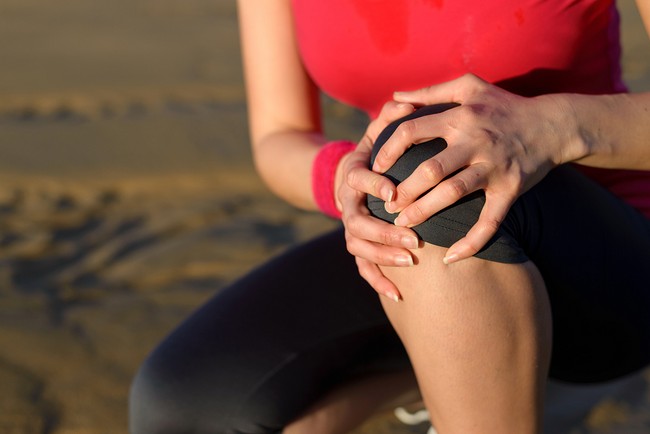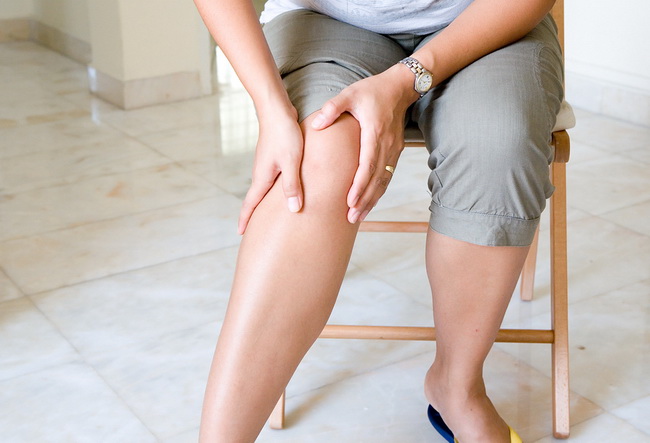- Make It Yourself Lavender Heart-Shaped Bath Bombs!
- 20 Things You Never Knew About “Down There”
- 12 Best Foods For Those Suffering From Arthritis Pain
- 12 Personal Hygiene Mistakes Almost Everyone Makes (Mom Never Told You About #4!)
- 15 Medicinal Plants And Herbs From The Cherokee People
- 12 Mind-Blowing Benefits Of Drinking Coconut Water During Pregnancy
- 12 Outstanding Winter Foods That Won’t Fatten You Up Like A Christmas Turkey
Top 5 Knee Problems: How to Fix Them and How to Avoid Them

Photo credit: bigstock.com
Someone once said that once you reach 50, you will miss your knees more than anything else. In a typical year, more than 10 million men and women will visit their doctors due to knee pain of one kind or another. Knees are one of the most commonly injured joints on the body and, as we get older, the joint most likely to become afflicted with arthritis. Besides pain, many people complain of strange feeling twinges, clicking or crunching noises, along with swelling and a tendency for the joint to sometimes simply seize up.
Knee problems are not inevitable, however. Knees are meant to last a lifetime provided they don’t get abused and are properly taken care of. Choosing a healthy lifestyle and activity level can help keep your knees strong, healthy, and more pliant. This means that you should be able to continue your favorite sport well into your 60’s, 70’s, 80’s, and beyond!
When everything is good inside your knee, it can easily handle loads of up to four times your body weight! Your knees are amazing joints that can gyroscope in three dimensions. It’s a remarkable piece of construction many of us do not appreciate until they begin to give us trouble.
Let’s take a look at the top 5 most common knee problems, how to avoid them, and how to fix them if they are already giving you trouble.
1. Runner’s Knee
Chondromalacia, patellofemoral syndrome, what we call runner’s knee, is a pain felt under the kneecap, directly in front of the knee. This pain typically gets worse when walking downstairs or squatting. Many people say they hear a clicking or grinding noise when walking downstairs.
This is caused by a softening or breakdown of the cartilage that is under the kneecap itself. This is often caused by poor kneecap alignment due to weak thigh muscles, muscle tightness, weak glute (fanny) muscles, or over pronation, which is when your foot rolls out the side when you walk or run.
Symptoms are usually brought on by a change in workout or the level of activity you are accustomed to. Many runners who increase their mileage suddenly will complain about this sudden pain in the front of their knee. Some women complain about this type of pain once their children hit about 12 to 16 months of age. Carrying around a 25 pound weight on one side of your body is bound to affect the knees.
How can you prevent and stop this type of injury?
Try to identify the trigger and look for ways to modify it. Carrying the baby in a back pack will distribute the weight more evenly over your body. Runners should slowly increase their mileage and build up to it. They should also look for shoes to correct their over pronation. Strengthening your core muscles, thighs, and glutes will also greatly help to support your knees.
2. Tendonitis
Many people only think of tendonitis as occurring in the wrist or elbow, but it can happen to knees as well. Tendonitis is when tendons, the tissues that connect our muscles to our bones, become irritated, swollen, and inflamed.
Tendonitis of the knees is almost always caused by overexertion. People who haven’t exercised in quite a while often take up jogging or other types of exercise after the New Years without allowing their bodies sufficient time to build up to these types of strenuous exercises. Runners who are trying to train for a marathon will go on extremely long runs on weekends, or just doing too many lunges and squats too quickly, all of which can lead to inflammation of the tendons. Find out how to get fit if you haven’t exercised for years.
How to avoid this problem? Cross training will help you use more than just your knees. You rarely see overuse injuries in triathletes who perform a wide variety of sports.
Don’t suddenly increase the intensity of your workouts more than 10 or 15 percent at a time. Also, don’t change more than one variable in your workout. For example, if you decide to run an extra 5 miles per week, don’t increase your speed as well. Wait until your body has become accustomed to the extra mileage before you try to increase your speed.
Continue to Page 2

Photo credit: bigstock.com
3. IT Band Syndrome
No, this isn’t a new Techno band; this is a knee problem that is common with tennis players, cyclists, and runners. This injury happens when the tissue that runs from the top of the hip to the outside of the knee, (called the IT band) becomes tight or develops inflammation. This causes pain on the outside of the knee, usually just about a mile or two into a run or a bike ride.
This is caused from overuse. When people cycle or run for several days in a row and do not allow their body’s sufficient time to rest and repair itself, the IT band often becomes inflamed. Training errors sometimes cause this problem, such as running on a sloping road for long distances where one leg is lower than the other.
How to avoid this? Allow your body sufficient time to rest. Cross training is always good as it gives the muscles you use for running a time to rest. If you are feeling this type of pain, give your body the break it needs. Ice, rest, and some anti-inflammatory medications for a week or two are usually all that are needed to correct this problem. Read also how to stop chronic pain naturally.
4. ACL Tear
This is usually what happens when people talk about their knee just “giving out”. Sometimes you hear a loud pop as the ligament tears. That noise is the anterior cruciate ligament tearing and it’s no joke. Swelling of the knee and some intense pain usually follows.
This often happens during a sudden change in direction when moving such as when playing soccer, or when you are hit on the side of the knee, such as when playing football.
What can you do? This is a tough one. You should see your doctor or an orthopedic specialist to determine exactly how much damage has been done. Sometimes physical therapy is sufficient, for other, surgery will be needed to avoid a lengthy recover period. See your doctor if you believe you have torn this ligament.
SEE ALSO: How to Make Your Own Homemade Tiger Balm: Recipes that Work!
5. Osteoarthritis of the Knee
Osteoarthritis is what happens when the cartilage in the knee breaks down. This leads to limited range of motion, stiffness, pain, and localized swelling.
Arthritis can happen from a previous knee injury. Being overweight can also bring this on. Genetic predisposition, tears, and fractures that affect the alignment of the knee, or repeated strains can all bring on osteoarthritis.
What can you do? See your doctor. Treatment generally includes anti-inflammatory medications, sometimes injections of hyaluronic acid helps. Hyaluronic acid is a natural substance that is part of the connective tissues, it helps to lubricate and cushion the knee joint.
The number one way to keep your knees happy and healthy is to maintain a healthy weight. Every extra pound you carry puts 4 pounds of added pressure on your knees when you walk or climb a flight of stairs. Losing even just 5 percent of your body weight often leads to less knee pain and greater flexibility of the knees.
Another thing that helps keep your knees healthy is movement. Although this might seem counterintuitive, knees need to be active to stay strong and healthy. When your knees aren’t used, they stiffen up and the muscles that support your knees begin to weaken. So stay active, even if your knee hurts, but take things easy until your knee heals.


































Amber
Jun 4, 2015 at 7:22 pm
This is a great article! The knee is one of the slowest for recovery rates. It gets such a small amount of circulation (the least actually). The bodies natural ability to heal brings any injured area blood flow, but the rate at which it does so, especially for the
knee, is very slow. To help increase mobility and and reduce the pain and stiffness with knee after an injury, focus on things that increase the blood flow (but with minimal strain on the knee). I recommend treatments that don’t require a lot of exertion in being able to do so. Things such as massage therapy, ultrasound, BFST,
acupuncture, etc. These types of treatment give you the nutrients and oxygen you need to heal but reduce the risk factors involved with a lot of physical activity. It’s also very important to follow anything physical with a cold compress. If the area is inflamed it hinders the blood flow even more than it would typically. Get the inflammation down, then increase the circulation. My main recommend is the BFST. I
have heard and seen the results first hand and think it is wonderful. http://www.kingbrand.com/Knee-Home.php?REF=46PV129.271